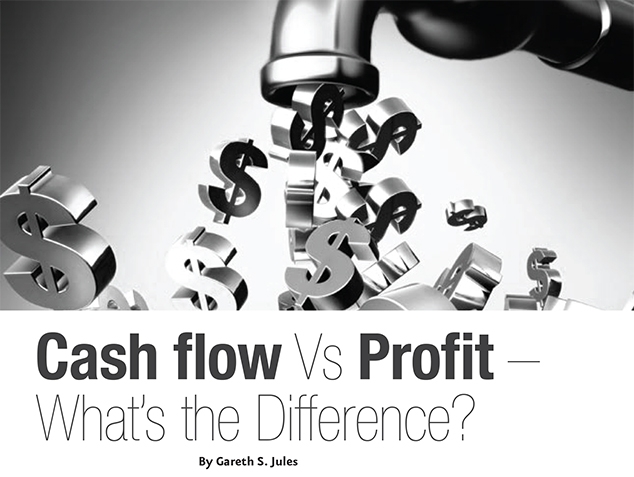
Not everyone is familiar with the term ‘cash flow’. However, many are quite familiar with the term ‘profit’. The two represent the difference between success and bankruptcy and they are often misunderstood.
Profit can simply be defined as revenue left over after all expenses have been deducted. Cash flow, on the other hand, represent funds flowing in and out of a company as a result of payments to suppliers and payments received from customers. Cash flow arises from operating, investing and financing activities. It gives an indication of the health of a company. The business can make a lot of profit but still have a negative cash flow, thus not being able to meet its financial obligations. Profits are seen as narrow, looking at revenue and expenses over a set period. On the other hand, cash flow is dynamic, and pertains to the time the movement of cash occurs.
 Profits are affected by revenues and expenses. The more a company increases its expenses, the more it decreases its ability to make a profit. Current assets and liabilities, plant equipment and investments, as well as long-term financing and dividends affect cash flow. Profit is derived from what is known as accrual accounting, which is a standard accounting practice, that provides a more accurate picture of the company’s current condition.
Profits are affected by revenues and expenses. The more a company increases its expenses, the more it decreases its ability to make a profit. Current assets and liabilities, plant equipment and investments, as well as long-term financing and dividends affect cash flow. Profit is derived from what is known as accrual accounting, which is a standard accounting practice, that provides a more accurate picture of the company’s current condition.
Two major factors that affect cash flow are buying and selling goods on credit. The longer a business allows its customers to pay their invoices, the higher the cash flow problem. Moreover, it won’t be able to pay its creditors on time, thus compromising its credit relations with the financing intuition and making it more difficult to obtain loans in the future.
Cash flows are important to a business’ solvency. They tell you something about the company’s past or can represent its forecasted future. If a company doesn’t have enough cash to maintain the payment of salaries and other expenses, it will find itself in a dilemma. It won’t have enough money to plough back into the business or invest in securities to generate further income. If a business is extremely profitable and has no cash reserves, to meet it’s financial obligations, it runs the risk of becoming bankrupt. Businesses therefore should make cash flow a priority.
 If a business has large cash reserves but isn’t very profitable, in the long run that cash position will deteriorate. It must move to a profitable trading position by either increasing revenue or by reducing costs. Cash flow can be negative when you earn a profit, and it can be positive when you incur a loss. For example, a company purchases a car for $15,000 and depreciates the car over a five-year period. It will incur a depreciation expense of $3,000 annually. No monies left the account after the first year of depreciation. The company makes a loss of $2,000 after the $3,000 depreciation expense was recorded. Bear in mind that no cash was used to record this expense. A depreciation expense reduces net income but does not involve the use of cash. If that depreciation expense was not recorded, the company would have made a profit of $1000 ($3,000-$2,000). Therefore, there is no natural correlation between profit and cash flow.
If a business has large cash reserves but isn’t very profitable, in the long run that cash position will deteriorate. It must move to a profitable trading position by either increasing revenue or by reducing costs. Cash flow can be negative when you earn a profit, and it can be positive when you incur a loss. For example, a company purchases a car for $15,000 and depreciates the car over a five-year period. It will incur a depreciation expense of $3,000 annually. No monies left the account after the first year of depreciation. The company makes a loss of $2,000 after the $3,000 depreciation expense was recorded. Bear in mind that no cash was used to record this expense. A depreciation expense reduces net income but does not involve the use of cash. If that depreciation expense was not recorded, the company would have made a profit of $1000 ($3,000-$2,000). Therefore, there is no natural correlation between profit and cash flow.
A good cash flow is vital to a business’ survival. While a profit makes it look good, a positive cash flow gives a true reflection of cash flowing in and out of the company which is essential to meet day-to-day expenses. Some techniques for increasing cash flow include extending the payables period with suppliers and selling securities. As a business owner, which is more important to you in the short and long run; high profits, high cash flow or a balance of the two? Be sure to prepare your cash flow statement on a monthly basis; it definitely helps!

